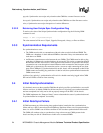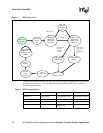
MPCMM0001 Chassis Management Module Software Technical Product Specification 29
Redundancy, Synchronization, and Failover
The active CMM will failover to the standby CMM if the active CMM cannot ping its first
SNMP trap address (SNMPTrapAddress1) over any of the available Ethernet ports, but the
standby CMM can. The trap address is set using the command:
cmmset –l cmm –d snmptrapaddress1 –v [ip address]
Only a ping failure of the first SNMP trap address (SNMPTrapAddress1) can cause a failover.
SNMPtrapaddress2 through SNMPtrapaddress5 do not perform this ping test.
Note: The frequency of the ping to the first trap address can vary from one second to approximately 20
seconds.
2. Critical events on the active CMM:
The active CMM has critical events for any of the CMM sensors (not critical chassis or blade
events) and the standby CMM does not. If both CMMs have critical CMM events, then the
number of major and minor CMM events is examined to decide if a failover should occur. The
number of major events is compared, and if they are equal, the number of minor events is used.
3.6.3 Manual Failover
The following command can be issued to the active CMM to manually cause a failover to the
standby CMM:
cmmset -l cmm -d failover -v [1/any]
Where:
1: Will failover only to a CMM with the same or newer version of firmware.
any: Will failover to any version of firmware.
A manual failover can only be initiated on the active CMM. A failover will only occur if the
standby CMM is at least as healthy as the active CMM. Once the command executes, the former
standby CMM immediately becomes the active CMM.
If the failover could not occur, the CLI will indicate the reason why the failover could not occur,
and a SEL event will be recorded.
In addition, opening the ejector latch on the active CMM will initiate a failover, but only if the
standby is at least as healthy as the active.
3.6.4 Scenarios That Force a Failover
The following scenarios cause a failover as long as the standby CMM is operational, even when it
is less healthy than the active:
• The active CMM is pulled out of the chassis.
• The active CMM’s healthy signal is de-asserted.
• A “reboot” command issued to the active CMM.
• The front panel alarm quiet switch button on the active CMM is pushed for more than five
seconds. If the button continues to be pressed for more than 10 seconds, the CMM does not
reset.


















